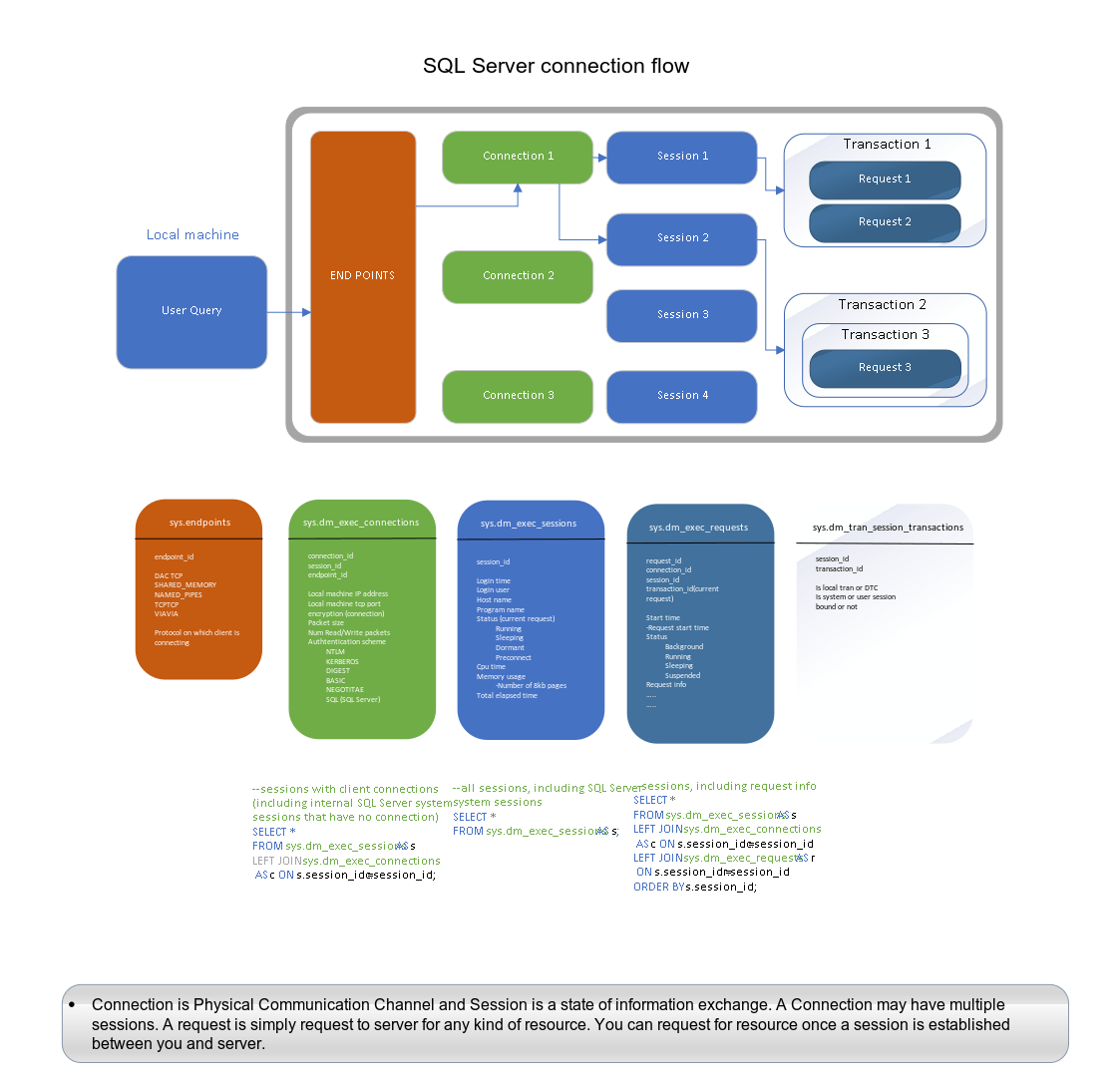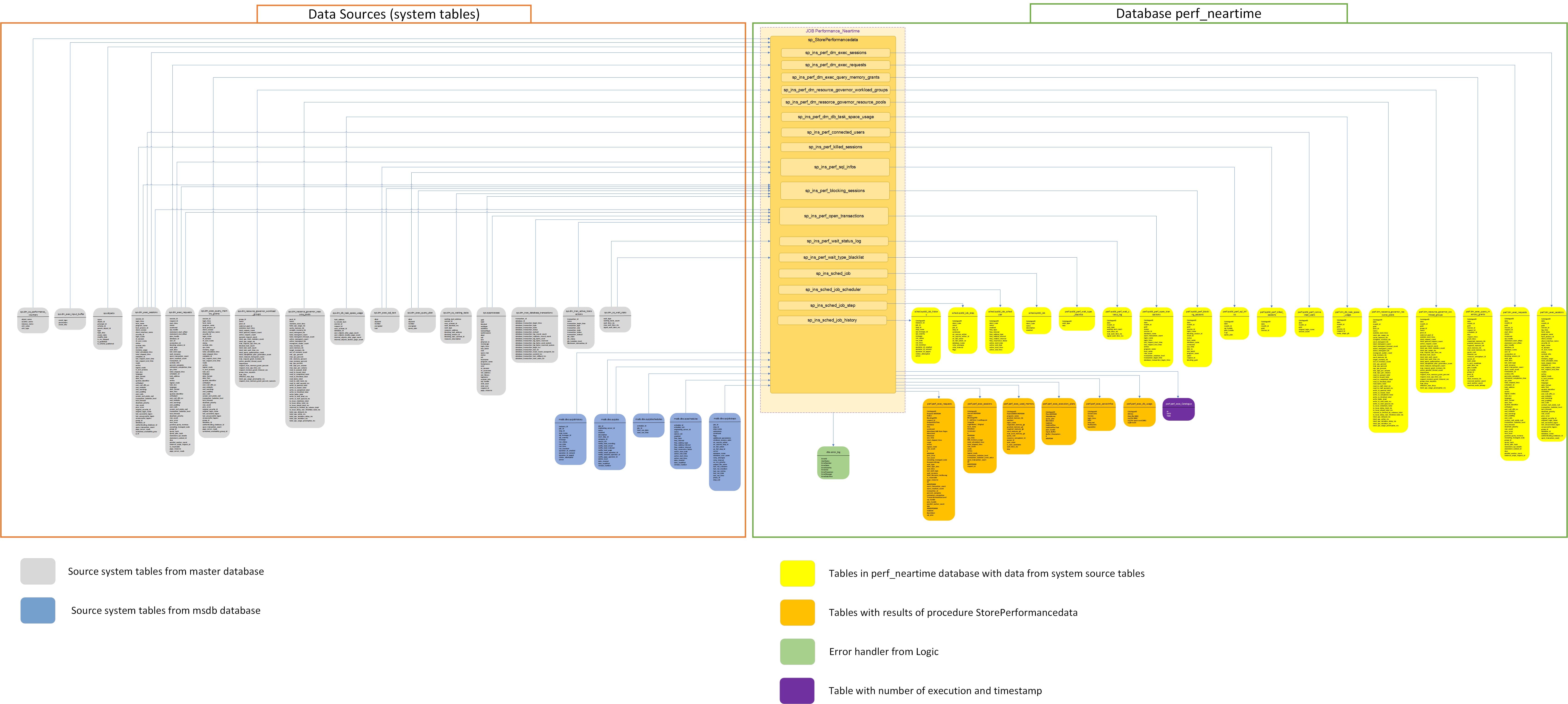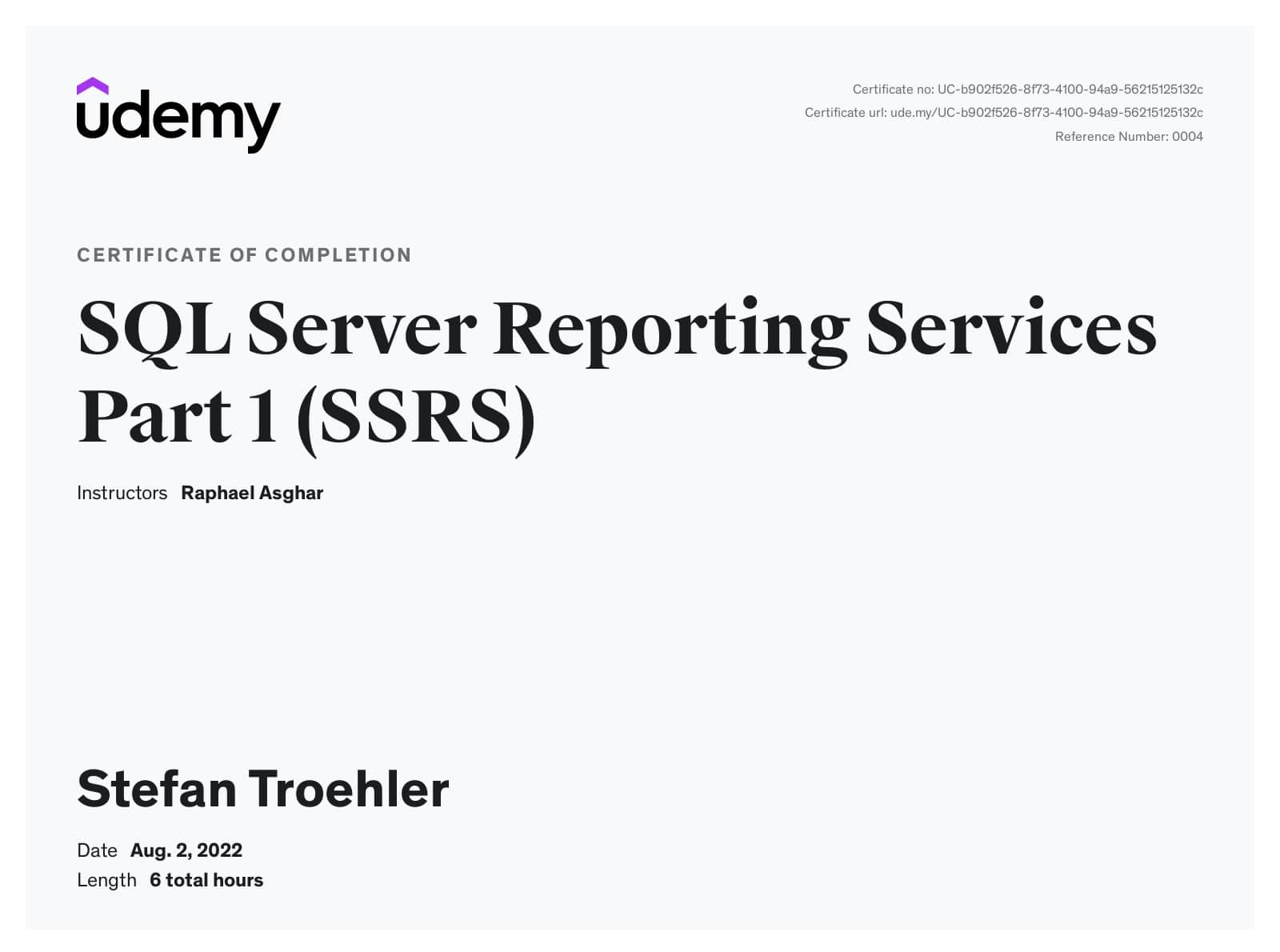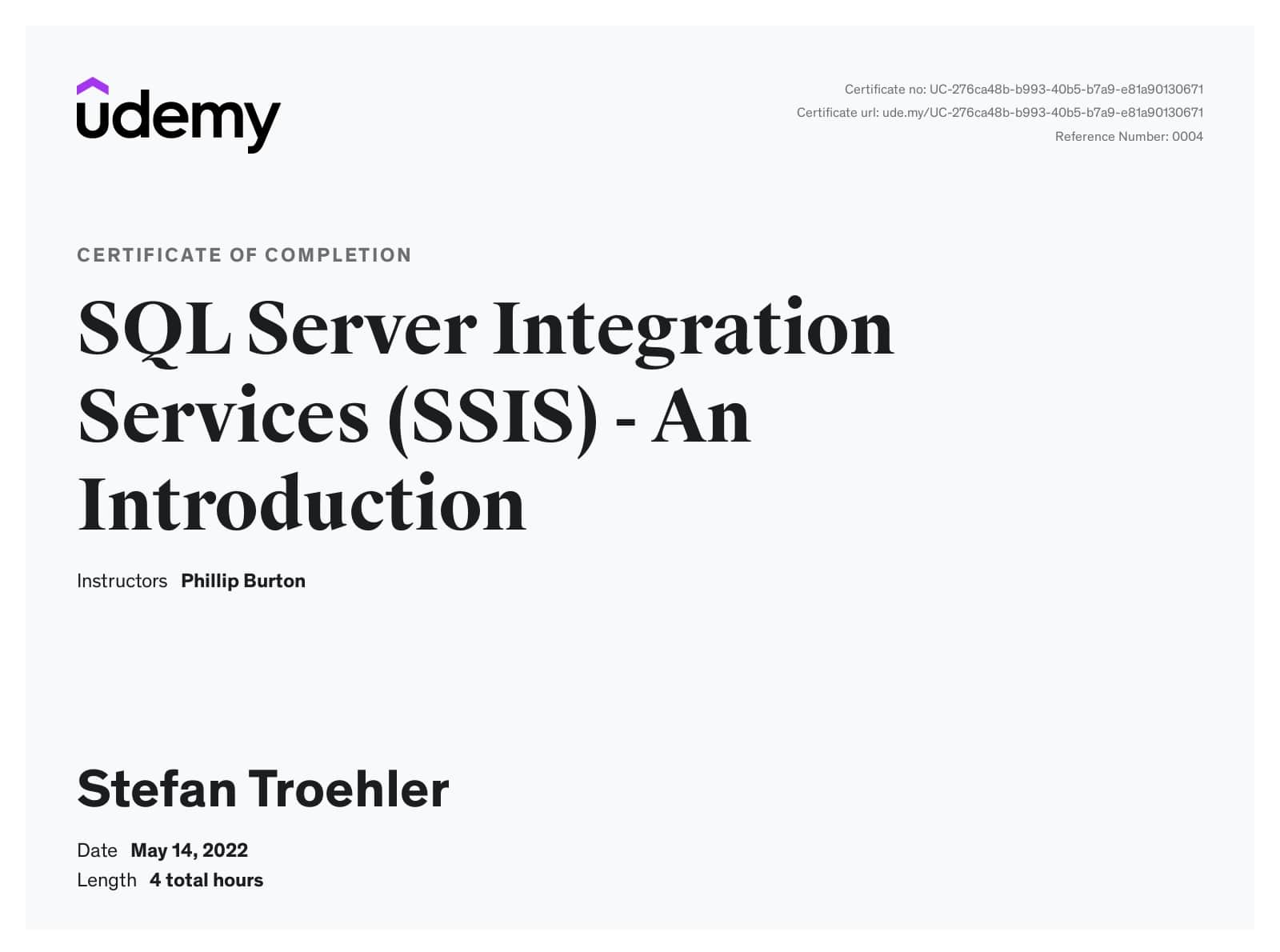
Introducing
SQL Server Performance Tuning
Techniques for improving SQL Server performance
In conclusion, SQL Server performance tuning is crucial for ensuring that database systems run efficiently and effectively. By implementing query optimization strategies, indexing techniques, and server configuration best practices, organizations can improve their SQL Server performance and ultimately enhance their overall business operations. It is important to regularly assess and fine-tune SQL Server performance to ensure that it meets the needs of the organization and its users. With the right techniques and strategies in place, organizations can optimize their SQL Server performance and achieve greater success in their business endeavors.
Database perf_querystore
Database perf_neartime
The database collects real-time data by capturing system activities and storing them in various tables. This data is saved every 5 minutes to ensure an up-to-date record of system performance. The process of data saving is initiated by a job named "Performance_Neartime" which executes a stored procedure called "StorePerformanceData" This job and stored procedure work together to retrieve the necessary information from the system and store it in the appropriate tables within the database.
The collected data provides valuable insights into the system's performance, allowing users to analyze and monitor various aspects of the system activities. By gathering data at regular intervals, it enables tracking changes and identifying trends over time. This information is crucial for system administrators and analysts to optimize system performance, troubleshoot issues, and make informed decisions regarding resource allocation and system configuration.
The data collected includes server information such as server name, version, login time, and session details. It also captures active requests, execution plans, database sizes, blocking sessions, workload group statistics, connected users, page allocation and deallocation activity, memory grants, executing queries, resource pool state, open transactions, wait status, scheduled jobs, and current memory usage. Each of these tables contains specific columns that hold relevant information related to the respective data category.

sys.dm_exec_sessions DMV includes user sessions as well as internal SQL Server sessions used to run background tasks. sys.dm_exec_connections contains additional information for sessions established by external clients, including protocol details. sys.dm_exec_requests contains information about active SQL Server requests (e.g. executing queries).Allocated memory view

perfsys.dm_exec_sessions – provides information about all active user connections and internal tasks. This includes client information such as application and host names, security settings, configuration settings, and other session-specific data.perfsys.dm_exec_requests – provides information about each request that is executing within SQL Server. This includes requests from user sessions, system sessions and internal processes.perfsys.dm_exec_query_memory_grants – provides information about all queries that have requested and are waiting for a memory grant or have been given a memory grant. perfsys.dm_exec_sql_text – information about SQL query text according to query sql_handle.dbo.tbl_query_store_plan_handle – represents the identifier for the memory location at which the actual execution plan for a given query is stored.Das Skript WhoTheFuckIsWrong.sql ist ein leistungsfähiges Tool zur Leistungsanalyse von SQL Server.
With script WhoTheFuckIsWrong.sql you can easy check which problem queries running on SQL Server in real-time.
In results of execution this script you will see all metrics to identify problem queries which take most resources of the SQL Server.
Some of most important metrics you can analyze in results of WhoTheFuckIsWrong.sql execution:
- Granted memory – allocated memory on server for query
- Used memory – fact used memory during query run
- Reads – number of reads performed by query
- Writes – number of writes performed by query
- CPU time – show in milliseconds how long CPU was busy by query
- Total elapsed time - show in milliseconds duration of query run
- SQL Statement – is SQL text of query
- SQL Plan – show Execution plan of query statement
You can also see from which server and application started query, and which user run the query.
Script WhoTheFuckIsWrong.sql is powerful tool for performance analyze on SQL Server.
Performance tunung Overview Full Database perf_neartime

Performance tunung Overview Full Database perf_querystore

Documentation
Optimizing Query Performance for Better Results
- 1. Use Execution Plans for Query Optimization
- 2. Optimize Index Usage
- 3. Eliminate Unused Indexes
- 4. Optimize Query Comparison with Wildcards
- 5. Optimize JOIN Operations
- 6. Avoid Multiple OR Conditions in FILTER Predicates
- 7. Use SELECT Fields Instead of SELECT *
- 8. Avoid SELECT DISTINCT
- 9. Regularly Update Query Statistics
- 10. Monitor and Fine-Tune Query Performance
- Conclusion
SQL Server Performance Tuning
SQL Server is a powerful database management system used by businesses and organizations to store and retrieve large volumes of data. However, as the size of databases and the complexity of queries increase, performance issues can arise, leading to slow query execution and decreased productivity. To overcome these challenges, it is essential to optimize SQL queries and improve query performance. In this article, we will explore effective SQL query optimization tips and techniques to enhance the performance of your SQL Server database.
Understanding Query Optimization Basics
Query optimization is a critical process that aims to improve the performance of SQL queries by utilizing system resources efficiently and optimizing performance metrics. The goal of query tuning is to reduce response time, minimize resource consumption, and identify and resolve poor query performance. By analyzing the execution steps of a query, applying optimization techniques, and considering other factors, such as indexes and execution plans, you can significantly enhance the performance of your SQL Server queries.
SQL Server Performance Tuning is a complex and painstaking process. Entrust this work to professionals.
I will gladly assist you in optimizing and setting up your company's database. Just call +41 (0)56 511 60 17 or contact me in any convenient way.
1. Use Execution Plans for Query Optimization
One of the key tools for SQL query optimization is the execution plan. When executing a query, the SQL Server query optimizer generates an execution plan that outlines the steps involved in query execution. The execution plan provides valuable insights into how the query is processed, including the use of indexes, join operations, and data retrieval methods. By analyzing the execution plan, you can identify potential bottlenecks and optimize the query accordingly.
To obtain the execution plan for a query, you can use tools such as SQL Server Management Studio or query profiling tools like dbForge Studio for SQL Server. These tools provide visual representations of the execution plan, making it easier to identify performance issues and areas for improvement. By understanding the execution plan, you can make informed decisions about index creation, join optimization, and other query optimization techniques.
2. Optimize index usage
Indexes play a crucial role in query performance optimization. They provide a means to retrieve data from tables more efficiently by creating an ordered structure of the table's rows. When executing a query, the SQL Server query optimizer may suggest the creation of missing indexes based on the query's execution plan. These suggested indexes can significantly improve query performance by reducing the need for full table scans and enabling faster data retrieval.
To optimize index usage, it is important to regularly review the execution plans of your queries and identify any missing indexes. You can utilize dynamic management views, such as sys.dm_db_missing_index_details and sys.dm_db_missing_index_columns, to gather information about suggested missing indexes. Additionally, consider the use of covering indexes, which include all the fields required by a query, to further enhance query performance.
However, it is important to note that adding indexes should be done judiciously. While indexes can improve query performance, they also introduce overhead in terms of disk space usage and maintenance. Therefore, carefully evaluate the impact of adding indexes on insert, update, and delete operations to ensure a balance between query performance and overall database performance
3. Eliminate Unused Indexes
While adding missing indexes can improve query performance, it is equally important to identify and eliminate unused indexes. Unused indexes consume disk space and require maintenance overhead without providing any significant performance benefits. Regularly review the usage statistics of your indexes and identify those that are not being utilized by your queries.
One common reason for unused indexes is implicit data type conversion. When queries involve data type conversions, such as comparing an integer column with a string value, indexes may not be utilized. To avoid this issue, ensure that comparisons are performed on compatible data types or use explicit data type conversion where necessary.
Another consideration is the use of filtered indexes. These indexes include a filter condition that limits the index to a subset of rows in a table. If the filter condition is not met in a query, the filtered index will not be utilized. Review your filtered indexes and ensure that the filter conditions align with the queries that need to access the indexed data.
By identifying and eliminating unused indexes, you can reduce the overhead associated with index maintenance and improve overall query performance.
4. Optimize Query Comparison with Wildcards
Wildcards are powerful tools for pattern matching in SQL queries. However, incorrect usage of wildcards can negatively impact query performance. When using wildcards, it is recommended to place them at the end of a phrase rather than at the beginning. Placing wildcards at the end allows for more efficient data retrieval, as it leverages index structures when available.
For example, consider a query that retrieves customer records based on their first name. Instead of using a wildcard at the beginning of the search term, such as LIKE '%John', use it at the end, such as LIKE 'John%'. This allows the query optimizer to utilize indexes efficiently and retrieve relevant data faster.
Additionally, when searching for specific patterns that involve the last characters of a word or phrase, consider using the REVERSE() function and creating a persisted computed column. By reversing the values and applying the wildcard search on the reversed column, you can optimize back-searching operations and improve query performance.
5. Optimize JOIN Operations
JOIN operations can significantly impact query performance, especially when dealing with large tables. To optimize JOIN operations, carefully analyze the execution plan and identify any unnecessary or redundant JOINs. In some cases, it may be possible to eliminate JOINs by splitting the query into separate parts and joining the results using the UNION operator.
Another technique for JOIN optimization is JOIN elimination. This involves removing unnecessary JOINs by rewriting the query to eliminate redundant tables or subqueries. By simplifying the query structure, you can enhance query performance and reduce the computational overhead associated with JOIN operations.
It is also important to ensure that the tables involved in JOIN operations are appropriately indexed. Indexing the columns used in JOIN conditions can significantly improve query performance by enabling faster data retrieval and reducing the need for full table scans.
6. Avoid Multiple OR Conditions in FILTER Predicates
In SQL queries, using multiple OR conditions in FILTER predicates can lead to poor query performance. When multiple OR conditions are present, the SQL Server optimizer evaluates each condition individually, which can result in inefficient query execution.
To optimize query performance, it is recommended to avoid using multiple OR conditions in FILTER predicates. Instead, consider splitting the query into separate SELECT statements and combining the results using the UNION operator. This allows the optimizer to process each condition separately and optimize the execution plan accordingly.
By minimizing the use of OR conditions and structuring queries effectively, you can significantly improve query performance and reduce resource consumption.
7. Use SELECT Fields Instead of SELECT *
When retrieving data from a SQL Server database, it is common practice to use the SELECT * syntax to retrieve all columns from a table. However, this approach can lead to inefficient query execution and unnecessary resource consumption.
To optimize query performance, it is recommended to specify the exact columns you need to retrieve instead of using SELECT *. By explicitly selecting the required fields, you reduce the amount of data transferred from the database to the client and minimize the computational overhead associated with processing unnecessary columns.
Additionally, using SELECT fields allows for better query optimization, as the query optimizer can generate more efficient execution plans based on the specific columns being retrieved. This can result in faster query execution and improved overall performance.
8. Avoid SELECT DISTINCT
The SELECT DISTINCT operator is often used to eliminate duplicate rows from query results. However, it can negatively impact query performance, especially when dealing with large datasets.
Instead of using SELECT DISTINCT, consider alternative approaches to achieve the desired functionality. For example, you can use GROUP BY clauses or subqueries to eliminate duplicates while maintaining better query performance.
By avoiding the use of SELECT DISTINCT and exploring alternative query structures, you can optimize query performance and improve overall database efficiency.
9. Regularly Update Query Statistics
Query statistics provide valuable insights into query performance and can help identify areas for optimization. SQL Server maintains statistics about data distribution in tables and indexes, which the query optimizer uses to generate efficient execution plans.
To ensure accurate query statistics, it is essential to regularly update them, especially after significant data modifications or index changes. By updating query statistics, you provide the query optimizer with up-to-date information about data distribution, enabling it to generate more accurate and efficient execution plans.
You can use the UPDATE STATISTICS command or leverage automated statistics updates provided by SQL Server to keep query statistics current. By incorporating regular statistics updates into your maintenance routine, you can optimize query performance and ensure accurate query optimization.
10. Monitor and Fine-Tune Query Performance
Optimizing SQL query performance is an ongoing process that requires continuous monitoring and fine-tuning. Regularly review the performance of your queries and analyze their execution plans to identify areas for improvement. Consider using performance monitoring tools and techniques, such as query profiling, to gain insights into query performance and identify performance bottlenecks.
Additionally, consider implementing query performance benchmarks and comparing the performance of your queries over time. This allows you to track performance improvements and identify areas where further optimization is required.
By monitoring and fine-tuning query performance, you can ensure that your SQL Server database operates at optimal efficiency and delivers fast and responsive query results.
Conclusion

My certificates









































































